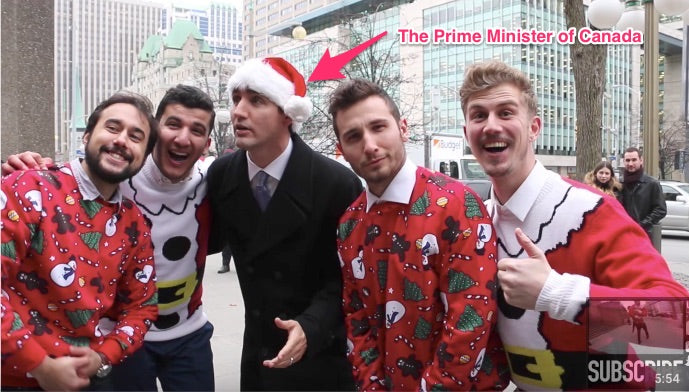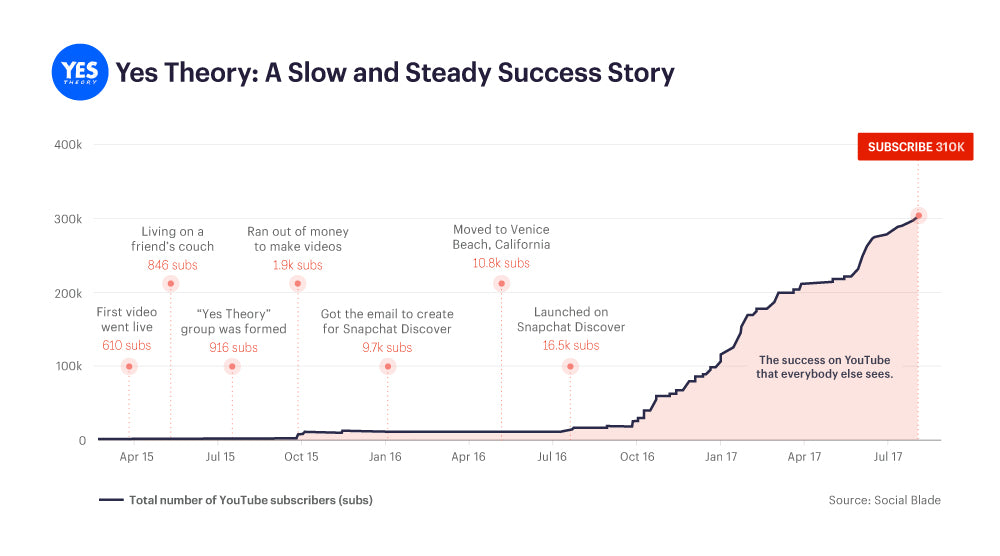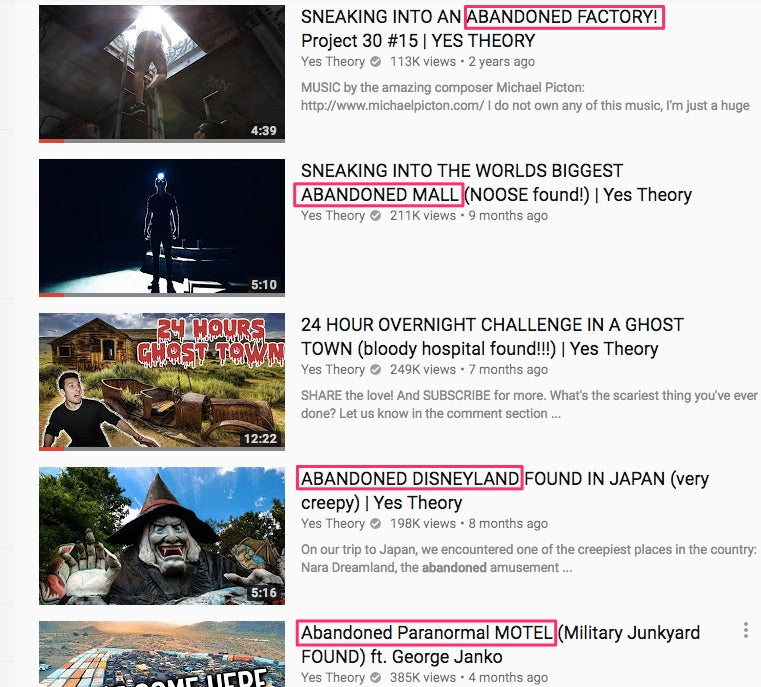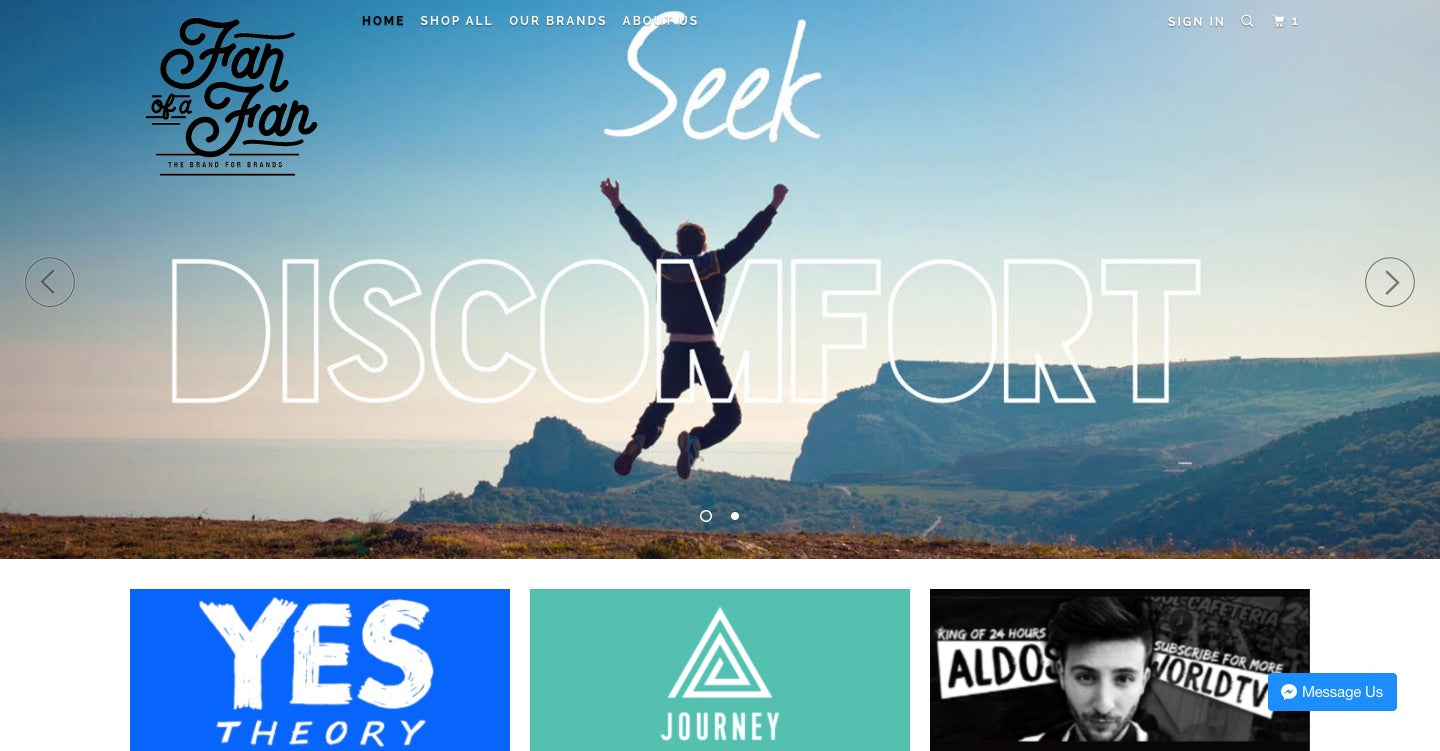Telling people—as a grown adult—that you want to drop everything to become a full-time YouTuber will probably earn you one of these looks: .
“Be realistic.”
“Only 1% make it.”
“Why are you wasting your time?”
These are the same voices that regularly tell us that our wishes and ambitions are too big for us. Sometimes we hear these voices from others and sometimes we hear them from ourselves. Either way, when we listen to them, we tend to stop before we even allow ourselves to start.
But for four strangers who came together by chance, leaving behind stable lives to make YouTube videos full time, there was a much different, much louder voice that they decided to listen to instead.
It's a voice they've embodied in their fast-growing YouTube channel:Yes Theory.
It's thanks to that voice, they’ve grown toover310,000 subscribers,and gone from living on a mutual friend’s couch in Montreal, Canada to getting a place in Venice Beach, California and travelling the world for free.
Along the way, they’ve made headlines on major media outlets likeBuzzFeedand Fox News, became friends with thePrime Minister of Canada, and exploded in popularity thanks to a partnership with a production company calledBrother系统网络体系结构(Sna),使内容pchat Discover.
I sat down with Matt Dejar, one of the members of Yes Theory, to talk about that often-ignored voice at the center of their YouTube channel’s philosophy, their journey, and the lessons they learned on the path to becoming full-time YouTubers.
Free Course: Build a Print-on-Demand Business
Learn how to easily create and sell your own custom-branded products. Ecommerce expert Adrian Morrison shares his framework for launching a successful print-on-demand shop in our free video course.
Enroll for freeThe “Yes Theory” Explained

Yes Theory is a fast-growing YouTube channel featuring four young strangers-now-friends from different walks of life.
Each of them put aside what most would call “stability” and “success” (much to the dismay of their parents) to pursue a risky, ambitious project that would come to be known as the “Yes Theory”:
- Matt Dejar: Basically quit being a “traditional entrepreneur”, shutting down a profitable streetwear company and supporting the channel with his savings.
- Ammar Kandil: Dropped out of a full-ride scholarship and turned down a $100K funding offer for his startup.
- Thomas Brag: Gave up a career in tech to focus on getting as good as he is today at video editing and storytelling.
- Derin Emre: Put a hold on the movie he moved to Montreal to co-write in order to join the rest of the guys as the cameraman.
Together, these otherwise normal guys in their 20s, have chosen to chronicle themselves completing improbable tasks, like diving from a helicopter into the ocean, despite a fear of heights, or finding a way to mingle with well-known billionaires.
At first glance, Yes Theory might seem no different than many other YouTubers who pull crazy stunts for views or inspire people to chase their dreams. But underneath it all is a story and a message about the power of saying “yes” to the only voice that really matters. And an initiative todemonstrateit to others by using their own lives.
In Matt’s own words, the Yes Theory is about answering “the voice in your head telling you ‘yes’ when everything else is telling you ‘no’."
"You know it's something you want to do, but everything else is telling you it's too scary, too dangerous, too whatever, but you know deep inside that you want to do it. It’s the idea of persistence, the idea of not taking ‘no’ for an answer and the idea of just going down the path that you actually want and trusting your gut.”
The inspirational stunts they pull are just the seeds of a much larger media enterprise and movement that they want to build to help others practice the “Yes Theory” to break from routine and live happier lives.
And, despite the channel's name, they’ve been met with a lot of no’s, which they talk about openly in their videos to avoid painting a picture of perfection that doesn’t exist.
After all,becoming a successful and self-sustaining YouTube channel—like any business— is far from easy, as they’re never shy about sharing.
Persisting Until You Get Lucky

Persistence is a recurring theme with these guys, across their channel, in their videos, and in my conversation with Matt.
If they failed in whatever they set out to do, it was never because of a lack of trying.
As much as the high quality of their content and their engaging storytelling format contributed to their current growth and success, you can see how much luck is involved in their videos when they attempt these highly unlikely tasks.
But if “luck” is being in the right place at the right time, then entrepreneurs make their own by working to be in as many places at as many times as they can until luck finally strikes.
You need to be patient and at peace with imperfection, according to Matt:
“I think the key is to understand that it's a long-term thing and that you're not going to figure everything out all at once. Create a bucket list and test out what you might like. Maybe you hate it and you stop doing that thing. Maybe you love it and you stick with it.”
“这是我的情况。我试图启动一个发髻OB欧宝娱乐APPch of different companies, and I was never too passionate about it. Then, the second you come across the right thing, it's just like, all right, this is what I'm sticking with.”
“The classic entrepreneurial mindset is to never quit. So when I quit [the company I started] I was like, 'Wow, I feel kind of shitty that I let this thing go, that I've been working on for two years.' I guess I just learned that something better comes along and you just have to hop on that train otherwise you're going to miss it.”
And sometimes that means just diving into what you want to do, and worrying less about the things everyone else worries about. Like having the right equipment.
Equipment Is Useless Without a Story
A common question many YouTubers get is about the kind of gear they use.
Yes Theory started out with a Canon EOS 70D and used Final Cut Pro 10 for video editing. But Matt says none of that would’ve been of any use if they didn’t know the story they wanted to tell.
Oftentimes, aspiring creators get caught up in investing in equipment rather than finding an overarching narrative they can consistently create within.
Matt talked about one of their inspirations, Casey Neistat, and how he himself, despite geeking out over vlogging gear, says that the most expensive equipment is pretty useless if you don't have the story for it.
Hotel desk work stationpic.twitter.com/KFxoosOhKY
— Casey Neistat (@CaseyNeistat)March 13, 2016
“人不会在乎这一点,除非你可以告诉他们that story," Matt says. But if the story you want to tell demands good gear, you can google around to find affordable cameras and microphones you can use, as well as free video editing tools. Many smartphones these days actually offer enough of what you need to start shooting.
But for aspiring YouTubers looking for an idea, Matt recommends followingAustin Kleon's adviceand stealing. Like an artist.
Or:"Create the piece of work you wish your favorite artist did."
For Yes Theory, in the beginning, that meant emulating Casey Neistat andMTV's Buried Lifewith their bucket list approach and editing style, before they found their own unique voice.
Execution, Ideation, and Keeping a Schedule
During their initialProject 30倡议启动通道,OB欧宝娱乐APPy shot themselves doing one spontaneous act every day for a month, the guys were putting out a video a day.
But as their direction evolved and the bar was raised, they started doing 2 videos a week, and are now ramping up to an output of 3 a week without sacrificing quality.
This sounds crazy when you consider the scale of some of their stunts and the obvious effort that goes into every video. But it's all possible as long as you plan ahead, according to Matt.
"We're usually about three weeks ahead on videos just in case anything happens. A lot of it, sometimes, is just timely. If there's a holiday or if there's something going on and we want to do something around that, then we'll do that. For example, there's a [certain high-profile sporting event] that's coming up. We want to do something around that. Can't say what, but we'll see how it goes."
Matt considers their output not that crazy compared to other YouTubers who've figured out their process: "I know some that'll make a video and have an editor that they send the footage too. By the time the YouTuber's up in the morning, the video's edited and ready to upload. I think that's brilliant."
"If your strong suit isn't editing and it's just filming and being an entertainer, then find somebody who can edit and don't waste eight hours of your day or more just learning how to edit. Unless you really, really want to learn how to edit."
"What works for us is we all have our skills. I have zero clue how to edit, I've never edited anything in my entire life. I barely know how to use a camera. My forte is just producing, organizing, doing brand deals. All this stuff that's not as technical. I think that's like any team, that's how it works. Just different structures."
Maintaining a Backlog of Good Ideas
As for coming up with fresh ideas and constantly having to one-up themselves, Matt says they just try to do things that are fun for them, trying different things and even creating recurring "mini-series" based on what's worked in the past.
"I think it's like any business where if you have a good product and people like it, you want to keep putting out more of that product. The Abandoned series, the Asking Billionaires For Things series, you see that it works. Obviously, you don't want to overdo it so that your channel only becomes that thing, but you've got to give the audience what they want a lot of the time in order to keep doing what you want."

"Once every three weeks we'll plan a video that we know [will work], like an Abandoned video that we know is going to get a lot of views but that's fun to do as well. Then, in between, we'll do stuff that we really want to do and push for ones that get people to know us better as well."
Putting Yourself Out there as a YouTuber
Putting yourself out there is always hard, especially early on when you've got very little validation. To top it off, not everything you make is going to be gold.
"It is a hard thing to decide when to self-promote. If you have a product that you're just like, 'People need to see this. This is really good and if they don't see it then they're missing out.' It's less like, 'Oh, I hope they see it so I benefit from it.' You really want to help people and inspire people. By doing it, it doesn't feel that selfish, in fact it feels pretty selfless. There you go, here's this gift. We hope you like it."
But there will always be certain anxieties you need to overcome as an entrepreneur or a creator. Matt says that the only way to beat them is through relentless action: "I think the only way you can do all that without being overwhelmed is by making the next video better than the last, pushing it to the media harder than you did the last time, getting more friends to share it than last time. Just pushing harder every day."
Action is the antidote for despair; just making stuff and releasing it and moving on to the next thing. Not thinking too deep into it.
Building a Tribe on Youtube (And Dealing With "Haters")
Though the few hundred thousand subscribers that Yes Theory has amassed isn't the same as the millions that other YouTubers have, the kind of engagement they get is definitely rare.
Their fans love them. Some of them even regularly pop into the comments to express their confusion as to why they don't have even more. And Yes Theory does a great job of responding to their community and being accessible to fans.

But it wasn't always that way. Every creator deals with haters, trolls, and negative comments. That's the price of admission.
"When it comes to haters, since day one we've had haters. That's part of life in general. If you don't become immune to it fast then you're not going to go far. Anybody will tell you that's beyond just YouTube."
However, Matt recalls how a lot of the worst hate to deal with was offline and early on.
"It was more dealing with family and friends being like, 'What the hell are you doing? You're a 23-year-old man out of college, you're educated, and you're starting a YouTube channel with zero subscribers. All your friends are getting real jobs, and making a lot of money.' You feel like shit. You're sharing these videos that get 200 views."
What kept them going was the fact that they chose something where they could lose themselves in the process each and every time.
"Even now, we take this stuff one step at a time. Just one step ahead. And we never really think about this enormous task of trying to survive with five people on a YouTube channel."
It's just a day-by-day grind and then eventually you look around and you're like, "Holy shit—it worked. We actually... We made it work!"
"Sometimes when I look around a room, I'm like, 'Wow, this is maybe 20 people.' It feels like a lot. Then you think about having 50,000 people watch a single video. We were freaking out when we got our first thousand views. We were like, "That's 1,000 *expletive* views from all over the world!? Are you kidding me? That's the coolest thing ever!"
You see this same level of excitement each time they share a milestone with their audience, even back when they hit 30,000 subscribers.
But according to Matt, the numbers have nothing on the moments when people share the impact Yes Theory's existence has had on them.
"Yea, it might be awesome if we can have a million views, ten million subscribers, but when a kid that lived in Cairo drives all the way to the pyramids, through the tourist line, through the security, just to see us in Egypt and tell us that we had inspired him—to have that kind of an impact on even a single kid, that's better than anything else in the world. It's what everybody talks about as 'purpose'. Having that purpose is what keeps you going for sure."
But in order to keep serving their audience with more content, they need to make money.
YouTubead revenue alone won't put food on the table for four.
Being Your Own Influencer to Make Money on Youtube
With a following of their size, there are plenty of ways to go aboutmaking money on YouTubeto help their project grow.
It's a matter of getting creative with how you look at yourself as a YouTuber, and for Matt and the others that meant drawing on their experiences from more traditional forms of entrepreneurship, particularlyinfluencer marketing.
“When I was running the streetwear brand... it wasn't unique whatsoever. Every day it feels like there's thousands of people starting a new clothing company. I was doing research into how you get your product out there, how do you get people to hear about it and all this stuff. And I kept reading the same thing: You've got to get celebrities or influencers to wear your product and shout it out. Then you're on the map. Then it's legitimate.”
“I started sending my product to everybody. I sent it to influencers, to actors, especially in Montreal. I did things with musicians at concerts. Then we started doing these videos and we were like, why don't we just become those people? That way we never have to beg anybody ever again to wear a shirt. Anytime we want to promote anything, we have hundreds of thousands of people who are ready to listen and hear us out. That's the idea: You just skip the middle step.”
In fact, the Yes Theory guys went a step beyond selling their own merch with a Shopify store calledFan of a Fanto help other YouTubers enter the merch game. They're looking to bring on more influencers to support, as well as explore other products they could launch as an extension of the Yes Theory media enterprise they're building.

They also do the occasional sponsored video—being careful and creative when it comes to not banging their audience over the head with an ad, or "selling out" as they plan to allow for more sponsorship deals. They recognize that it's just something they can't avoid, but want to approach it in a way that's respectful of their audience.
"I totally understand selling out in terms of we're not going to have Exxon Mobile sponsor us. It's going to be a brand we like and we know the people from."
Finally: Saying No (Occasionally)
Routine is what robs us of our time and the chance to live fulfilling lives.
Every entrepreneurial journey—whether it's a YouTube channel like Yes Theory, a business, or a blog—often begins with a resounding "YES!". But it stays alive based on your ability to say "no" to certain things.
For Yes Theory, they now say no to a lot of the things most people their age do (that Matt admits he used to do): "To be honest we say no a lot to partying. We don't party that much. We work so much, especially when we're in LA that just anytime a lot of friends are going out and getting drunk, and all that stuff, we just don't feel the need to do it."
"No" means making some sacrifices, like choosing a minimalist lifestyle to bootstrap your venture, turning down a Friday night out to edit a video, cutting out toxic people, or even putting your lesser dreams on hold for your bigger ones.
But still, we're met with choices and moments, life-changing and day-changing, where we deprive ourselves of fulfillment instead of answering our gut with a confident 'yes'.
That's what the Yes Theory is about and none of what you just read would exist if not for that 3-letter word.


